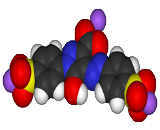Tartrazine (TZ)
[Edit]Trisodium 1-(4-sulfonatophenyl)-4-(4-sulfonatophenylazo)-5-pyrazolone-3-carboxylate)

| CCC | K524 |
| CAS | 1934-21-0 |
| Wiki | Tartrazine |
Tartrazine is a synthetic lemon yellow azo dye primarily used as a food coloring. Tartrazine is a commonly used color all over the world, mainly for yellow, but can also be used with Brilliant Blue FCF (FD&C Blue 1, E133) or Green S (E142) to produce various green shades. Tartrazine appears to cause the most allergic and intolerance reactions of all the azo dyes, particularly among asthmatics and those with an aspirin intolerance.
Many foods contain tartrazine in varying proportions, depending on the manufacturer or person preparing the food, although the recent trend is to avoid it or substitute a non-synthetic dyeing substance such as annatto, malt color, or betacarotene.When in food, tartrazine is typically labelled as "color", "tartrazine", or "E102", depending on the jurisdiction, and the applicable labelling laws.
Organism species: Pan-species (General)
| CATALOG NO. | PRODUCT NAME | APPLICATIONS | |
| Proteins | CPK524Ge11 | BSA Conjugated Tartrazine (TZ) | Immunogen; SDS-PAGE; WB. |
| CPK524Ge21 | OVA Conjugated Tartrazine (TZ) | Immunogen; SDS-PAGE; WB. | |
| Antibodies | PAK524Ge01 | Polyclonal Antibody to Tartrazine (TZ) | WB; IHC; ICC; IP. |
| Assay Kits | CEK524Ge | ELISA Kit for Tartrazine (TZ) | Enzyme-linked immunosorbent assay for Antigen Detection. |
